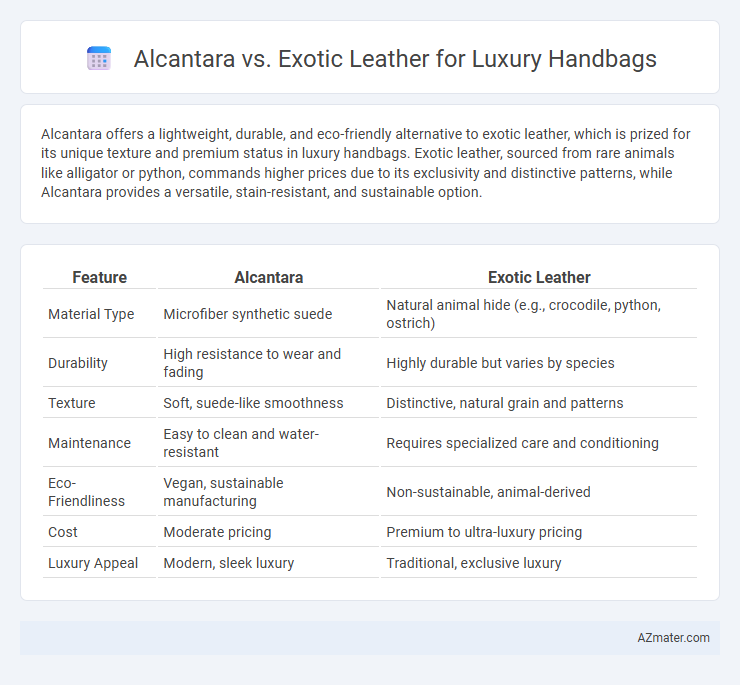Alcantara offers a lightweight, durable, and eco-friendly alternative to exotic leather, which is prized for its unique texture and premium status in luxury handbags. Exotic leather, sourced from rare animals like alligator or python, commands higher prices due to its exclusivity and distinctive patterns, while Alcantara provides a versatile, stain-resistant, and sustainable option.
Table of Comparison
| Feature | Alcantara | Exotic Leather |
|---|---|---|
| Material Type | Microfiber synthetic suede | Natural animal hide (e.g., crocodile, python, ostrich) |
| Durability | High resistance to wear and fading | Highly durable but varies by species |
| Texture | Soft, suede-like smoothness | Distinctive, natural grain and patterns |
| Maintenance | Easy to clean and water-resistant | Requires specialized care and conditioning |
| Eco-Friendliness | Vegan, sustainable manufacturing | Non-sustainable, animal-derived |
| Cost | Moderate pricing | Premium to ultra-luxury pricing |
| Luxury Appeal | Modern, sleek luxury | Traditional, exclusive luxury |
Introduction to Luxury Handbag Materials
Alcantara and exotic leather are premium materials renowned in luxury handbag craftsmanship for their unique textures and durability. Alcantara, a synthetic microfiber, offers a soft, suede-like feel with high resistance to wear and stains, making it a practical yet elegant choice. Exotic leathers, sourced from rare animals such as alligators, ostriches, and snakes, provide distinctive patterns and exclusivity, elevating a handbag's status and appeal among luxury consumers.
What is Alcantara? Key Properties and Features
Alcantara is a premium synthetic material composed of approximately 68% polyester and 32% polyurethane, known for its suede-like texture and exceptional durability. It offers breathability, stain resistance, and easy maintenance, making it an ideal alternative to exotic leather in luxury handbags. Its lightweight nature, combined with high abrasion resistance and eco-friendly production process, distinguishes Alcantara as a sustainable and versatile choice for high-end fashion accessories.
What Qualifies as Exotic Leather? Definitions and Varieties
Exotic leather for luxury handbags typically refers to materials sourced from non-traditional animals such as alligator, crocodile, ostrich, python, and stingray, prized for their unique textures and rarity. These leathers offer distinctive patterns and durability, making them highly sought after in high-end fashion markets. Alcantara, by contrast, is a synthetic microfiber material known for its suede-like feel, durability, and stain resistance, providing a modern alternative to exotic leathers without the ethical and environmental concerns.
Durability: Alcantara vs. Exotic Leather
Alcantara offers exceptional durability with resistance to fading, staining, and wear, making it an ideal choice for luxury handbags that need to maintain their appearance over time. Exotic leather, such as crocodile or python, provides high durability with unique textures but requires careful maintenance to prevent cracking and discoloration. Both materials excel in longevity, yet Alcantara's synthetic composition ensures a more consistent durability under varied environmental conditions.
Aesthetic Appeal: Texture, Color, and Style
Alcantara offers a sleek, suede-like texture that enhances luxury handbags with a soft, matte finish appealing to contemporary aesthetics and available in a wide spectrum of vibrant colors. Exotic leather, such as alligator or ostrich, provides a distinctive, natural grain and patina that exudes exclusivity and timeless elegance with rich, complex hues unique to each hide. The choice between Alcantara and exotic leather impacts the handbag's style narrative, where Alcantara supports modern minimalism and exotic leather embodies classic, high-end sophistication.
Sustainability and Ethical Considerations
Alcantara offers a sustainable alternative to exotic leather, made from renewable raw materials and featuring a lower environmental footprint due to its eco-friendly manufacturing process. Exotic leather, often sourced from endangered or protected species, raises ethical concerns related to animal welfare and illegal trade practices, impacting biodiversity negatively. Choosing Alcantara supports ethical luxury fashion by promoting cruelty-free production and reducing reliance on finite natural resources.
Maintenance and Care Requirements
Alcantara requires minimal maintenance, needing only regular gentle brushing or wiping with a damp cloth to prevent dirt buildup, and it is resistant to stains and fading compared to exotic leather. Exotic leather, such as alligator or ostrich, demands specialized care including conditioning with specific products to maintain suppleness and protect against drying or cracking. Avoiding prolonged exposure to sunlight and moisture is crucial for both materials, but exotic leather's higher sensitivity increases maintenance complexity and cost.
Price Comparison: Alcantara vs. Exotic Leather
Alcantara offers a cost-effective alternative to exotic leather, often priced significantly lower while maintaining a luxurious feel and durability ideal for high-end handbags. Exotic leathers such as alligator, python, and ostrich can command prices several times higher due to their rarity, unique textures, and complex sourcing processes. Consumers seeking luxury handbags balance price sensitivity with exclusivity, where Alcantara provides an affordable yet premium-quality option compared to the premium cost of exotic leather materials.
Popular Brands and Their Material Choices
Popular luxury handbag brands like Gucci and Prada favor Alcantara for its lightweight durability and suede-like texture, enhancing comfort and modern aesthetics. In contrast, Hermes and Louis Vuitton often choose exotic leathers such as alligator and python, emphasizing exclusivity and rich texture that appeal to collectors. These material choices reflect brand identity, with Alcantara aligning with contemporary innovation, while exotic leathers represent timeless luxury and rarity.
Conclusion: Choosing the Right Material for Your Next Luxury Handbag
Alcantara offers a sustainable, lightweight, and durable alternative to exotic leather, which is prized for its unique textures and natural patterns derived from rare animal skins like python and crocodile. When selecting the right material for your luxury handbag, consider factors such as ethical sourcing, maintenance requirements, and the desired aesthetic impact. Choosing between Alcantara and exotic leather ultimately depends on your values around sustainability and exclusivity, as well as the intended use and longevity of the handbag.

Infographic: Alcantara vs Exotic Leather for Luxury Handbag
 azmater.com
azmater.com